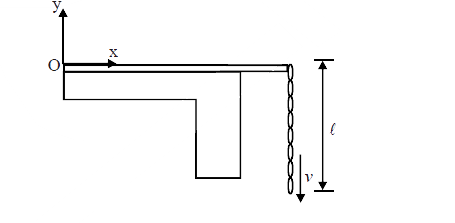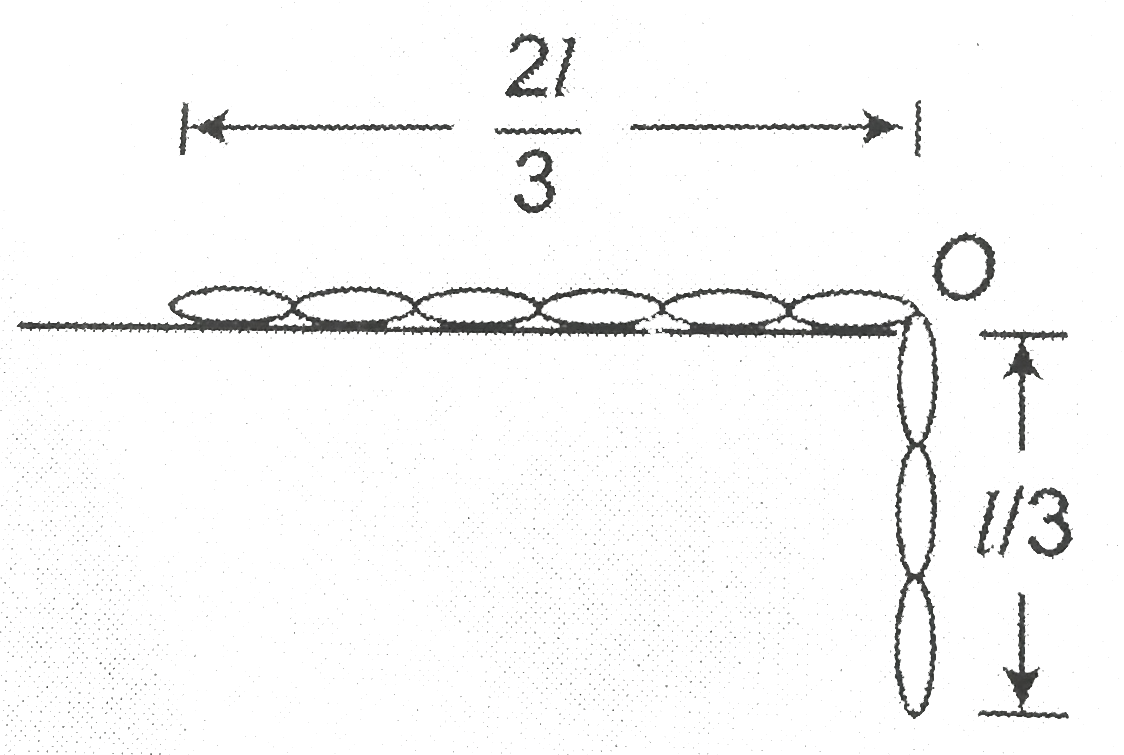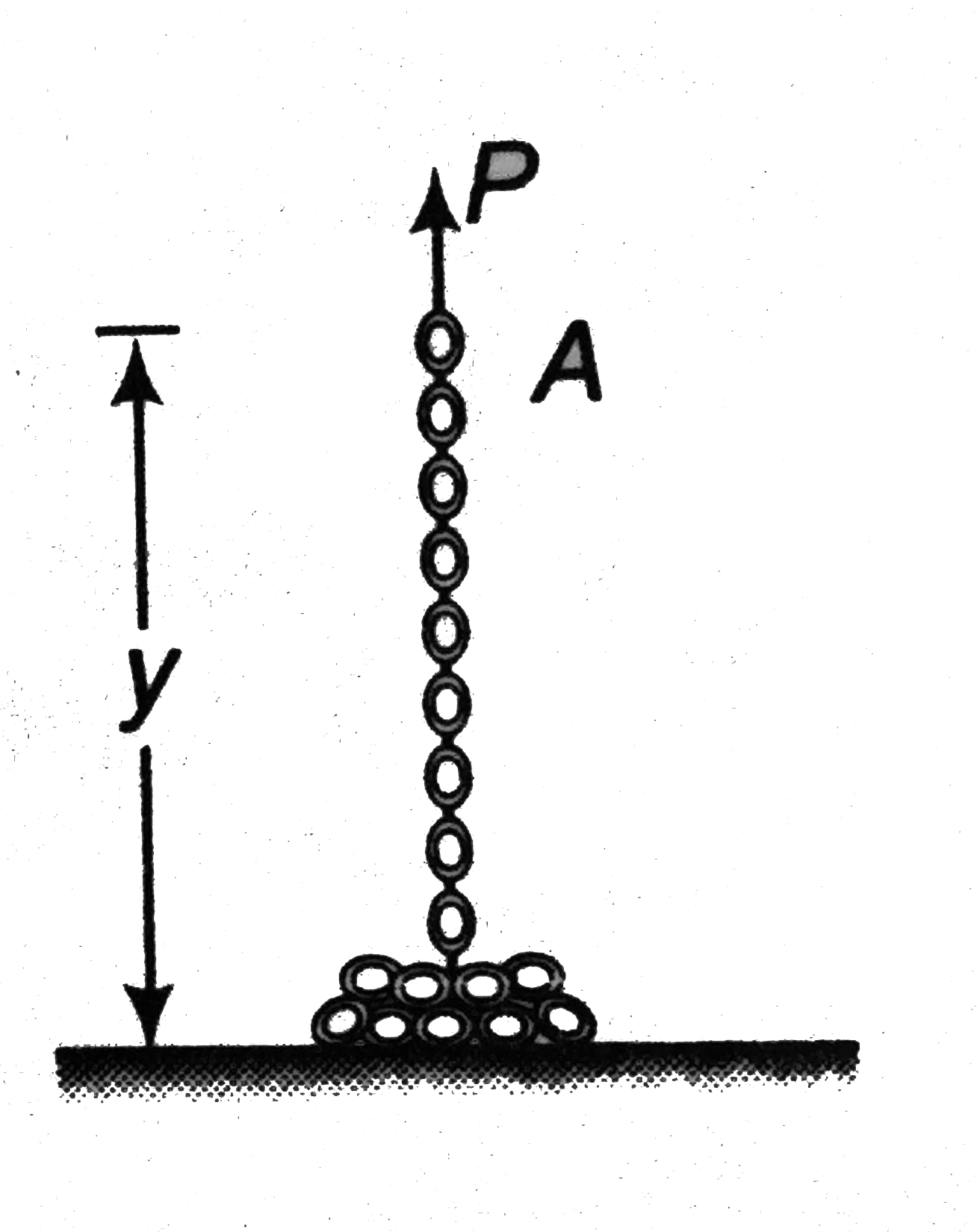A chain of length l=80cm and mass m = 2 kg is hanging from the end of plane so that the length lo of the vertical segment is 50 cm as shown in the figure. The other end of the chain is fixed by a nail. At a certain instant, the nail is pushed out, what is the velocity of the chain at the moment it completely slides off the plane ? Neglect the friction.

We assume the zero potential energy level at the horizontal plane. The initial and final configuration of the chain are shown in the figure. Initially, KEin=0
Uin=0+(mll0)g(−l02)
or Uin=−ml202lg
Note that the part of chain lying over the table has zero potential energy.

Finally, KEf=12mv2
Where v is the final velocity of the chain. and Uf=−mg.12
Using the law of energy conservation
KEf+Uf=KEin+Uin
12mv2−mg.l2=0−ml20g2l
or v=√gl(l2−l20)
Putting l=0.8m,l0=0.5m,g=10m/s2, we get
v=√5.1m/s
or v=2.23m/s
Topper's Solved these Questions
- WORK, POWER & ENERGY Book:MOTIONChapter:WORK, POWER & ENERGY Exercise:SOLVED EXAMPLES
Explore 5 Videos
- WORK, POWER & ENERGY Book:MOTIONChapter:WORK, POWER & ENERGY Exercise:QUESTIONS FOR PRACTICE
Explore 25 Videos
- WORK, POWER & ENERGY Book:MOTIONChapter:WORK, POWER & ENERGY Exercise:Exercise - 3 Section-B
Explore 22 Videos
- WAVESBook:MOTIONChapter:WAVESExercise:EXERCISE -4 (Level -II) (previous year JEE Advanced)
Explore 10 Videos
Similar Questions
A uniform chain of mass m and length l is placed on a smooth table so that one−third length hanges freely as shown in the figure. Now the chain is released, with what velocity chain slips off the table?

View SolutionA chain of mass m and length L is over hanging , from the edge of a smooth, horizontal table such that , 3/4th of its length is lying on , the table .The work done in pulling the chain completely , on to the table is
View Solution
Knowledge Check
A chain AB of length l is located in a smooth horizontal tube so that its fraction of length h hangs freely and touches the surface of the table with its end B(figure). At a certain moment the end A of the chain is set free. With what velocity will this end of the chain slip out of the tube?
 Ah√2gLhB√2ghloge(Lh)C√2glloge(Lh)D1hL√2g
Ah√2gLhB√2ghloge(Lh)C√2glloge(Lh)D1hL√2gA chain of length L and mass m is placed upon a smooth surface. The length of BA is (L−b). Calculate the velocity of the chain when its and reaches B
 A√2gsinθL(L2−b2)B2√gsinθL(L2−b2)C√gsinθL(L2−b2)D√gsinθ2L(L2−b2)
A√2gsinθL(L2−b2)B2√gsinθL(L2−b2)C√gsinθL(L2−b2)D√gsinθ2L(L2−b2)A uniform chain of length / and mass mis hanging vertically from its ends A and B which are close together. At a given instant the end B is released. What is the tension at A when B has fallen a distance x (x<l)?
Amg2[1+3xl]Bmg[1+2xl]Cmg2[1+xl]Dmg2[1+4xl]
A uniform chain of mass m0 and length l rests on a rough incline with its part hanging vertically as shown in the fig. The chain starts sliding up the incline (and hanging part moving down) provided the hanging part equals η times the chain length (η lt 1). What is the work performed by the friction force by the time chain slides completely off the incline. Neglect the dimension of pulley and assume it to be smooth.

View SolutionA chain of length l and mass m is lumped over the hole in a horizontal plate and a short length hangs down the hole when the chain is at rest. If it is released from this position find the velocity when the last link of the chain leaves the hole.
View SolutionA chain AB of length l is located in a smooth horizontal tube so that its fraction of length h hangs freely and touches the surface of the table with its end B(figure). At a certain moment the end A of the chain is set free. With what velocity will this end of the chain slip out of the tube?

View SolutionA thin, uniform chain is hanging vertically and its bottom end is touching a table . The mass of the chain is m and its length is l . At the moment t=0, the chain is released. Calculate the force that the chain exerts on the table after t seconds.
View SolutionA chain of length l and mass m lies in a pile on the floor. If its end A is raised vertically at a constant speed v0, express in terms of the length y of chain which is off the floor at any given instant.
(a) The magnitude of the force P applied to end A.
(b) Energy lost during the lifting of the chain.

View Solution

